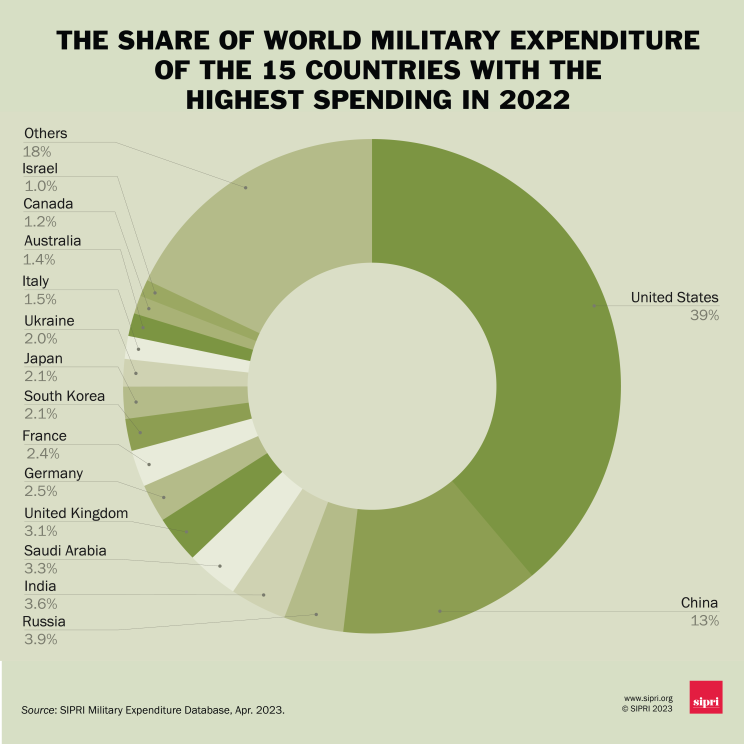Increased Global Military Expenditure: The Impact Of The War In Ukraine

Table of Contents
The Surge in Global Defense Budgets
The war in Ukraine has acted as a catalyst, accelerating pre-existing trends and prompting a significant reallocation of resources towards defense. This surge is evident across the globe, impacting both NATO and non-NATO members.
Increased Spending by NATO Members
Since the beginning of the war, NATO members have witnessed a dramatic increase in their defense budgets. This reflects a renewed focus on collective security and a recognition of the evolving threat landscape. Many countries have committed to increasing their defense spending to meet the 2% of GDP target set by NATO.
- Increased procurement of advanced weaponry: This includes increased orders for advanced fighter jets, missile defense systems, and other cutting-edge military technologies. Examples include the increased demand for US-made weaponry and the accelerated development of European defense capabilities.
- Expansion of military personnel: Several NATO nations are expanding their armed forces, increasing both the number of active personnel and reserve forces. This reflects a need for greater readiness and capacity for potential future conflicts.
- Investment in cybersecurity and intelligence: Recognizing the importance of information warfare and hybrid threats, many NATO countries have significantly increased their investments in cybersecurity infrastructure and intelligence gathering capabilities.
Specific examples include the substantial increases in defense budgets seen in countries like the UK, Germany, and Poland, representing a clear commitment to bolstering national security.
Non-NATO Countries Increasing Spending
The impact of the war in Ukraine extends beyond NATO borders. Many non-NATO countries, particularly in regions like Asia and the Middle East, are also experiencing a surge in military expenditure. This is driven by a variety of factors, including regional instability and perceived threats from external actors.
- Regional conflicts and power dynamics: Ongoing conflicts in several regions, coupled with evolving geopolitical dynamics, are compelling nations to increase their military capabilities. This is particularly true in the Asia-Pacific region, where tensions between major powers are on the rise.
- Perceived threats from external actors: The war in Ukraine has heightened concerns about potential aggression from external actors, prompting several nations to bolster their defenses to deter potential attacks. Countries are reviewing their national security strategies and investing in defensive capabilities.
- Modernization of existing military capabilities: Many nations are modernizing their militaries, upgrading outdated equipment and investing in new technologies. This involves significant investment in research, development, and procurement.
Countries like South Korea, Japan, and several nations in the Middle East have already announced significant increases in their defense spending, reflecting the global nature of this trend.
Economic Consequences of Increased Military Expenditure
The dramatic rise in global military expenditure carries significant economic consequences, both domestically and internationally.
Opportunity Costs and Budgetary Strain
Increased military spending places a significant strain on national budgets. This necessitates difficult choices between defense spending and other crucial areas, leading to opportunity costs.
- Reduced social spending: Increased defense budgets often come at the expense of social programs, such as healthcare, education, and infrastructure. This can lead to long-term consequences for a nation's human capital and overall well-being.
- Increased national debt: Many countries are financing increased military spending by borrowing, which leads to a higher national debt burden. This can impact long-term economic stability and reduce a nation’s ability to address future crises.
- Potential inflationary pressures: The increased demand for military goods and services can put upward pressure on prices, contributing to inflation.
The economic trade-offs associated with increased defense spending need to be carefully considered and evaluated to avoid long-term detrimental impacts on overall economic health.
Impact on Global Markets and Resource Allocation
The increase in global military expenditure has a significant impact on global markets, particularly the arms market.
- Increased demand for weapons and military technology: The demand for weapons and military technology has surged, leading to increased production and higher prices.
- Impact on supply chains: The increased demand strains global supply chains, impacting the availability of materials and skilled labor.
- Competition for resources: The increased demand for raw materials and specialized components used in military production can create competition for resources, driving up prices and potentially creating shortages.
Geopolitical Implications of the Spending Increase
The surge in global military expenditure has profound geopolitical implications, reshaping alliances and power dynamics.
Shifting Power Dynamics and Alliances
The increase in military spending is altering the global balance of power, strengthening some alliances and potentially leading to the formation of new ones.
- Strengthening of NATO: The war in Ukraine has strengthened NATO's resolve and prompted a renewed focus on collective defense. This has increased cooperation and coordination among member states.
- Increased tensions between major powers: The increased military spending by major powers increases the potential for conflict and exacerbates pre-existing tensions.
- New military partnerships: Some countries are forming new military partnerships to counter perceived threats and enhance their security.
The shifting geopolitical landscape requires a nuanced understanding of the complex interplay between military strength and diplomatic relations.
The Arms Race and the Risk of Escalation
The current increase in global military expenditure raises concerns about the possibility of a new arms race, with potentially devastating consequences.
- Increased military deployments: The increased military spending could lead to heightened military deployments and an increased risk of accidental conflict.
- Heightened risk of accidental conflict: Increased military activity increases the risk of miscalculation and accidental conflict.
- Deterioration of diplomatic relations: The focus on military build-up can overshadow diplomatic efforts to resolve disputes and contribute to a deterioration in relations between countries.
Preventing an arms race and mitigating the risk of escalation requires a concerted diplomatic effort, focusing on conflict resolution and arms control.
Conclusion
The war in Ukraine has undeniably led to a dramatic increase in global military expenditure, with far-reaching economic and geopolitical consequences. The surge in defense budgets, driven by perceived threats and a desire for enhanced security, presents both opportunities and challenges. Understanding the complexities of this situation is crucial for navigating the future of international relations. We must consider the long-term implications of this increased global military expenditure and work towards diplomatic solutions to de-escalate tensions and prevent further escalation. Continued monitoring of global military spending is vital for informed decision-making and the pursuit of a more peaceful and secure world. For further insights into the impact of the Ukrainian conflict on global military expenditure, continue researching reputable sources on international security and defense.

Featured Posts
-
 Timberwolves Defeat Nets Edwards Dominant Game In Minnesota Win
May 01, 2025
Timberwolves Defeat Nets Edwards Dominant Game In Minnesota Win
May 01, 2025 -
 Kogda Ovechkin Pobet Rekord Grettski N Kh L Daet Noviy Prognoz
May 01, 2025
Kogda Ovechkin Pobet Rekord Grettski N Kh L Daet Noviy Prognoz
May 01, 2025 -
 Processo Becciu Data Dell Appello E Affermazione Di Innocenza
May 01, 2025
Processo Becciu Data Dell Appello E Affermazione Di Innocenza
May 01, 2025 -
 Caso Becciu Condanna Al Risarcimento Per 40 000 Euro
May 01, 2025
Caso Becciu Condanna Al Risarcimento Per 40 000 Euro
May 01, 2025 -
 Verdeelstation Oostwold Bewoners Voelen Zich Niet Gehoord
May 01, 2025
Verdeelstation Oostwold Bewoners Voelen Zich Niet Gehoord
May 01, 2025
Latest Posts
-
 England Vs France Six Nations Dalys Late Show Decides Tight Contest
May 02, 2025
England Vs France Six Nations Dalys Late Show Decides Tight Contest
May 02, 2025 -
 Australian Rugby Under Fire Phipps Highlights Global Decline
May 02, 2025
Australian Rugby Under Fire Phipps Highlights Global Decline
May 02, 2025 -
 Sources Confirm Nikki Burdines Departure From Wkrn News 2 Morning Show
May 02, 2025
Sources Confirm Nikki Burdines Departure From Wkrn News 2 Morning Show
May 02, 2025 -
 Late Daly Try Secures Englands Thrilling Six Nations Victory Against France
May 02, 2025
Late Daly Try Secures Englands Thrilling Six Nations Victory Against France
May 02, 2025 -
 Phipps Questions Australian Rugbys Super Sides Dominance
May 02, 2025
Phipps Questions Australian Rugbys Super Sides Dominance
May 02, 2025
